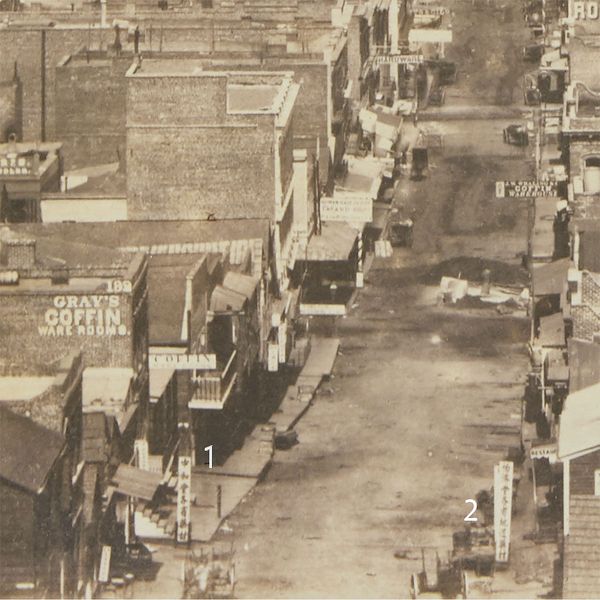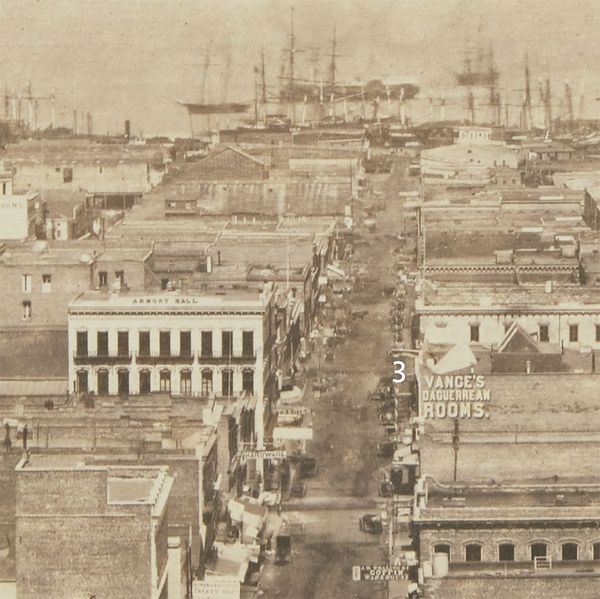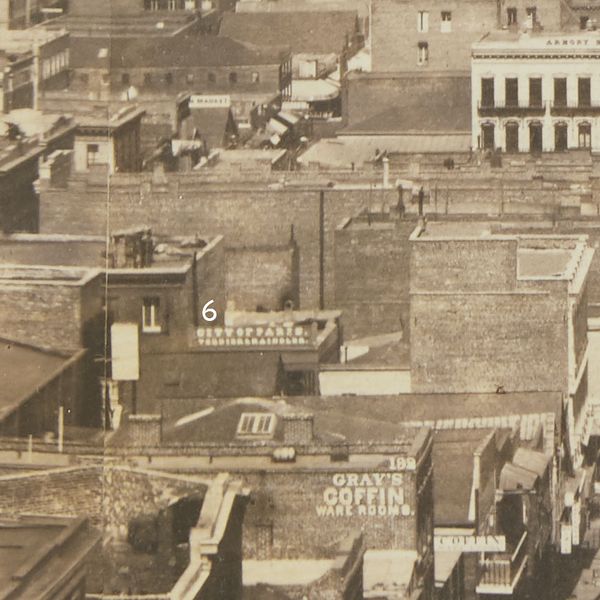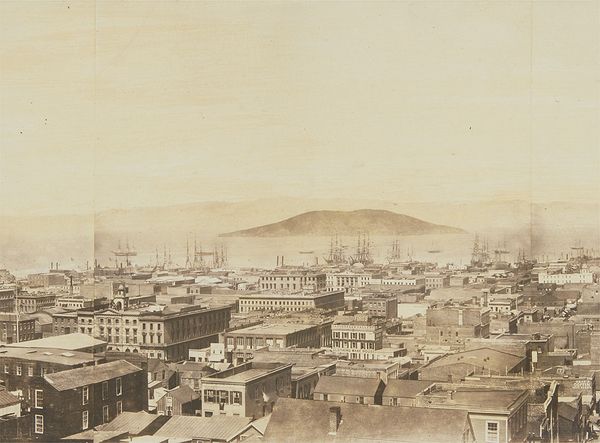George Robinson Fardon, San Francisco, Cal. (detail), 1855. Photographs, New York.
On a clear day in 1855, photographer George Robinson Fardon (1807-1886) climbed to the roof of a building on Stockton and Sacramento Streets in San Francisco, set up his camera, and made a series of seven exposures that documented the young city. While a number of panoramas of the city had been attempted before with the daguerreotype process, Fardon was the first photographer to try it with the new technology of wet-plate glass negatives. This allowed him to capture a vast array of detail and make prints on paper that could be mounted contiguously, creating a single sweeping view of the city. Fardon’s achievement is remarkable, but today only four examples of this seminal American photographic document are known. Phillips’s 12 October Photographs sale features one of these panoramas, a previously unseen version with a provenance extending deep into California history.

George Robinson Fardon, San Francisco, Cal., 1855. Photographs, New York.
Fardon’s vista proceeds from north to south, encompassing the view straight down Stockton Street in its first panel; proceeding to Telegraph Hill, showing the harbor and Yerba Buena Island; the view down Sacramento Street; and, in the last panel, the view over Happy Valley. Within its scope, the panorama sets forth a myriad of minute detail documenting businesses, residences, and public buildings. It is one of the earliest and most complete photographic documents of the city.

1 & 2: Chinese-language business signs on Sacramento Street.
In 1855, San Francisco was a vibrant and growing settlement. The teeming harbor, bristling with tall-masted ships, is indicative of vigorous trade and thriving businesses. New brick buildings are seen throughout the city, replacing older, more flammable wood structures. A block with Chinese-language business signs shows the early Asian presence in the city (1 & 2). The panorama offers not just a glimpse but a prolonged visual meditation on the 19th century cityscape. For the modern viewer with a magnifying glass and a bit of time, this rare photographic document delivers up a feast of detail.

3: Studio of Robert H. Vance, daguerreotypist, Sacramento Street.
When gold was discovered in California in 1848, fortune hunters flooded into San Francisco, using it as a base camp. Photographers were one class of merchant catering to the miners, and daguerreotype studios cropped up throughout the city to make their portraits. Three such businesses can be seen in Fardon’s panorama. The studio of Robert H. Vance, on Sacramento and Montgomery Streets, is recognizable by its bold signage (3). James M. Ford’s Daguerrean Gallery is conspicuous in the fourth panel, above Keyes & Co. Golden Gate Clothing Warehouse at the corner of Clay and Kearny Streets (4). Less conspicuous in the same panel is another daguerreotype studio: the partially obscured sign for the Cosmopolitan Daguerrean Gallery is visible on what is likely Clay Street (5).

4: Studio of James M. Ford, daguerreotypist, Clay and Kearney Streets. 5: The Cosmopolitan Daguerrean Gallery.
Another recognizable storefront is the City of Paris department store — which remained in business until 1976 — founded by Frenchmen Felix and Emile Verdier (6). The pair first sailed into San Francisco with imported merchandise in 1850 to such demand that they sold out before unloading the ship, the Ville de Paris. After replenishing their stock, the brothers opened their first location on the corner of Sutter and Kearney Streets. In the 6th panel, St. Mary’s Cathedral, which still stands on California Street and Grant Avenue, was still in construction when Fardon photographed it (7).

6: City of Paris department store.
Born in England, Fardon worked in San Francisco only briefly, arriving around 1854 and relocating permanently to Vancouver Island in 1858. During that short period, Fardon integrated himself into San Francisco’s vibrant photographic community, producing views of the city and its notable buildings and sites. Today, Fardon’s work does not survive in quantity, making it extremely rare. The Getty Museum and the Bancroft Library at UC Berkeley each have an example of the panorama, and another resides in a private collection. This is the only example of Fardon’s panorama to appear at auction.

7: St. Mary’s Cathedral at California Street and Grant Avenue.
William Franklin Whittier (1832-1917), the original owner of the panorama, likely acquired it from Fardon himself. A highly successful Bay Area businessman, Whittier is perhaps best known for the San Francisco mansion that bears his name on Jackson Street at Laguna. He was also one of the founders of Hemet, California. According to family history, the Fardon panorama hung in Whittier’s offices in San Francisco and has remained in the family — out of view — ever since.
Discover More from Photographs, New York >
Recommended Reading
The Big Picture: Photographs from the Amon Carter Museum of American Art >
How Peter C. Bunnell Inspired an Entire Generation of Photography >
